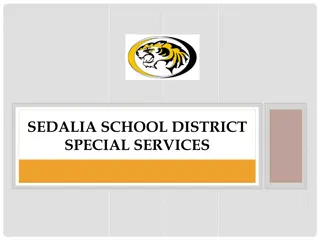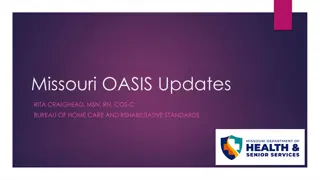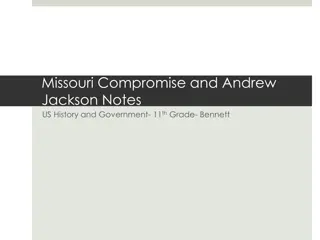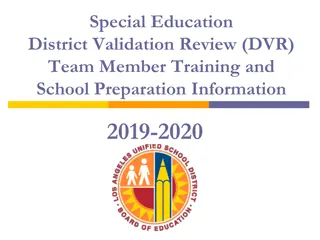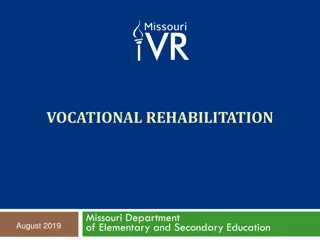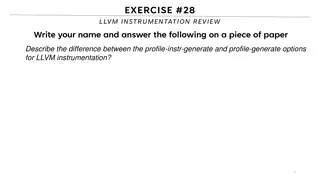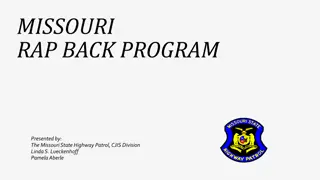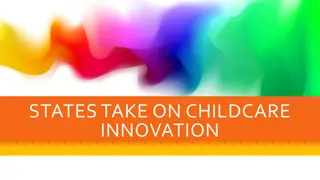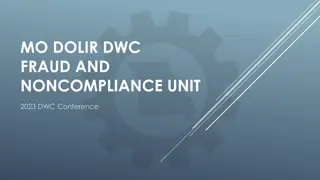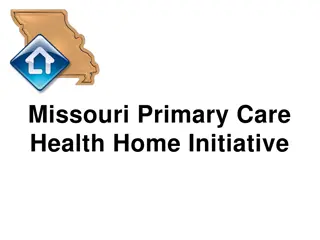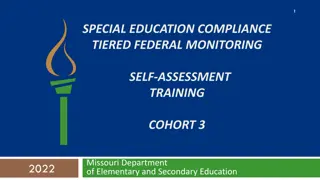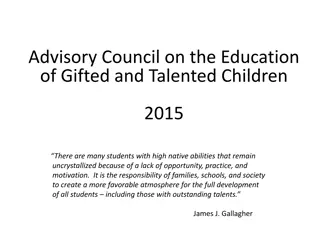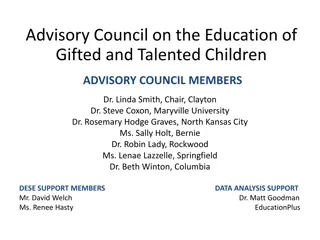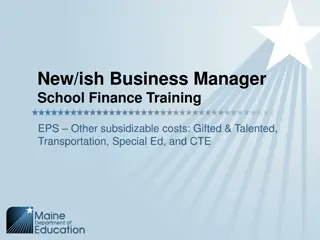Special Education Data and District Profile in Missouri 2023
This data and district profile report by the Office of Special Education in Missouri provides valuable insights into early childhood special education, educational environments, transition from First Steps, and early childhood outcomes. It highlights the importance of updated data on Core Data screens and the significant role of educators and staff in ensuring accurate information. The report emphasizes indicators such as children in special education programs, eligibility timelines, and outcomes related to social-emotional skills, knowledge acquisition, and behaviors. It serves as a comprehensive resource for evaluating and enhancing special education initiatives in the state.
Download Presentation

Please find below an Image/Link to download the presentation.
The content on the website is provided AS IS for your information and personal use only. It may not be sold, licensed, or shared on other websites without obtaining consent from the author.If you encounter any issues during the download, it is possible that the publisher has removed the file from their server.
You are allowed to download the files provided on this website for personal or commercial use, subject to the condition that they are used lawfully. All files are the property of their respective owners.
The content on the website is provided AS IS for your information and personal use only. It may not be sold, licensed, or shared on other websites without obtaining consent from the author.
E N D
Presentation Transcript
SPECIAL EDUCATION DATA AND DISTRICT PROFILE Office of Special Education Missouri Department of Elementary and Secondary Education 2023
Where does the Data Come From 2 The Short Answer is You! Core Data MOSIS entry on the Core Data Screens Pulled and housed in our data warehouses. Make sure that you update the data on your Core data screens, including updated emails and staff.
Table A1 ECSE Child Count 3 Early Childhood Special Education Child Count as of December 1 Data Source: MOSIS December Student Core Data Note: Generally reported by the district providing services
Table A2 ECSE Educational Environments (Ages 3-PK5) 4 SPP Indicator 6A: ECSE children in regular early childhood program receiving majority of services in the regular early childhood program SPP Indicator 6B: ECSE children in special education separate class, school or residential setting Data Source: MOSIS December Student Core Calculations: Educational environment percentage = (educational environment count / total ECSE child count) x 100
TableA3 Transition from First Steps (Part C) 5 SPP Indicator 12: Percent of children referred by First Steps prior to age 3 who are found eligible for ECSE, and who have an IEP developed and implemented by their third birthdays Eligibility Requirement: IEP in place prior to 3rd birthday Data Source: Special Education IMACS Self-Assessment Calculations: o Percent developed within acceptable timelines = (IEPs developed within acceptable timelines / number referred and eligible) x 100
Table A4 Early Childhood Outcome (ECO) Data 6 SPP Indicator 7: Percent of children in ECSE who demonstrated improved social-emotional skills, acquisition and use of knowledge skills, and use of appropriate behaviors to meet needs Data Source: ECO data from the MOSIS June Student Core File Calculations: Outcomes Percentage = (number in each outcome bucket for each outcome area / number of children exited from ECSE during reporting year) x 100 Summary Statement 1 = Of those children who entered the program below age expectations, the percent that substantially increased their rate of growth by the time they exited = (outcome buckets c + d / Outcome buckets a + b + c + d) x 100 Summary Statement 2 = Percent of children who were functioning within age expectations by the time they exited = (outcome buckets d + e / Outcome buckets a + b + c + d + e) x 100
Table B1 Child Count (5K-21) & Parentally-Placed Private School Students (PPPS) 7 Includes: The number of students with IEPs or Services Plans as of December 1 Data Source: MOSIS December Student Core Calculations: Incidence Rate for each Disability Category & Total = (total child count / total student enrollment) x 100
Special Education Child Count 8 The Child Count data includes all students receiving special education services: Students enrolled and attending the district Home-schooled students Parentally-placed private school students Students placed by IEP team in a private setting Children in Early Childhood Special Education NOT students in MSB, MSD or MSSD These students are reported by MSB, MSD and MSSD
Table B2 Percent of Students by Race/Ethnicity 9 SPP Indicators 9 & 10: Disproportionate representation in special education & disproportionate representation in specific disability categories Data Sources: MOSIS December Student Core (child count) and MOSIS October Student Core (enrollment) Calculations: Percent of Enrollment by Race = (the number in each racial & ethnic category / total enrollment) x 100 Percent of IEP Child Count by Race = (the number in each racial & ethnic category / total child count) x 100 Percent of Disability by Race (for each disability category = (the number in each racial & ethnic category / total child count in the disability category) x 100
Table B3 School-Age Educational Environments 10 SPP Indicator 5: Percent of children with IEPs inside regular class 80% or more (5A), Percent of children with IEPs inside regular class less than 40% (5B), and Percent of children with IEPs served in separate settings (5C) Data Source: MOSIS December Student Core Calculations: Educational Environment Percentage = (total number in educational environment / total school age special education child count) x 100
Table C Missouri Assessment Program (MAP) Data 11 IEP MAP & MAP-Alternate (MAP-A) participation and proficiency rates Data Source: MAP assessment data SPP Indicator 3: Participation rate for children with IEPs for English Language Arts and Mathematics (3B) & Proficiency rate for children with IEPs for English Language Arts and Mathematics (3C)
Table D Evaluation Data 12 SPP Indicator 11: Percent of children who were evaluated within 60 days of receiving parental consent for initial evaluation Data Source: Special Education IMACS self-assessment data Calculation: Percent with Acceptable Timelines = (number within acceptable timelines / number evaluated) x 100
Table E Parent Survey Data 13 SPP Indicator 8: Percent of parents who report that the school facilitated parent involvement as a means of improving services and results for children with disabilities Data Source: Special Education Parent Survey The school encourages parents to be involved My involvement in my child s education has improved his/her achievement Calculation: Schools Facilitated Parental Involvement Percent = (number of parents with children with disabilities who agree or strongly agree / number of responses) x 100
Table F Suspension/Expulsion Data 14 Counts: Suspension/expulsion counts and removal rates for students with disabilities and non-disabled students SPP Indicator 4: Percent of districts with significant discrepancy in the rate of suspensions and expulsions of greater than 10 days in a school year for children with IEPs (4A) and by race/ethnicity (4B) Data Source: MOSIS Discipline Incident file
Table G1 Graduation and Dropout Data 15 SPP Indicators 1 & 2: Percent of youth with IEPs graduating with regular diploma & percent of youth with IEPs dropping out New Calculation: We now calculate based on the Number of Exiters as a percent of Exiters. Calculation: Graduation: G01s with IEPs / The number of Students with IEPs that exited special education. Drop Out: Students with IEPs who Dropped out. (codes 07 and 08) / The number of students with IEPs that exited special education. Data Source: MOSIS June Student Enrollment and Attendance file
Table G2 Secondary Transition Plans 16 SPP Indicator 13: Percent of youth ages 16+ with IEPs that include: Appropriate measurable postsecondary goals that are annually updated and based upon an age appropriate transition assessment; Transition services, including courses of study, that will reasonably enable the student to meet those postsecondary goals; and Annual IEP goals related to the student s transition services needs Data Source: Student file reviews in IMACs self-assessment Calculation: Percent Met Requirements = (number met requirements / number of transition IEPs reviewed) x 100
Table G3 Follow Up 17 Follow-up:Previous year s graduates and dropouts SPP Indicator 14: Percent of youth who had IEPs, are no longer in secondary school and who have been enrolled in higher education, employed competitively, enrolled in some other postsecondary education or training program, or in some other employment within one year of leaving high school. Data Source: MOSIS Graduate follow-up file
Special Education Data Contacts 18 Mary Corey Coordinator Mary.Corey@dese.mo.gov 573-751-8165 Tori Chance Data Planner Tori.Chance@dese.mo.gov 573-522-0071 Seunghee Han Data Planner Seunghee.Han@dese.mo.gov 573-526-4995 Karris Bouslaugh Data Specialist Email: Website: Karris.Bouslaugh@dese.mo.gov 573-751-7848 speddata@dese.mo.gov https://dese.mo.gov/special-education
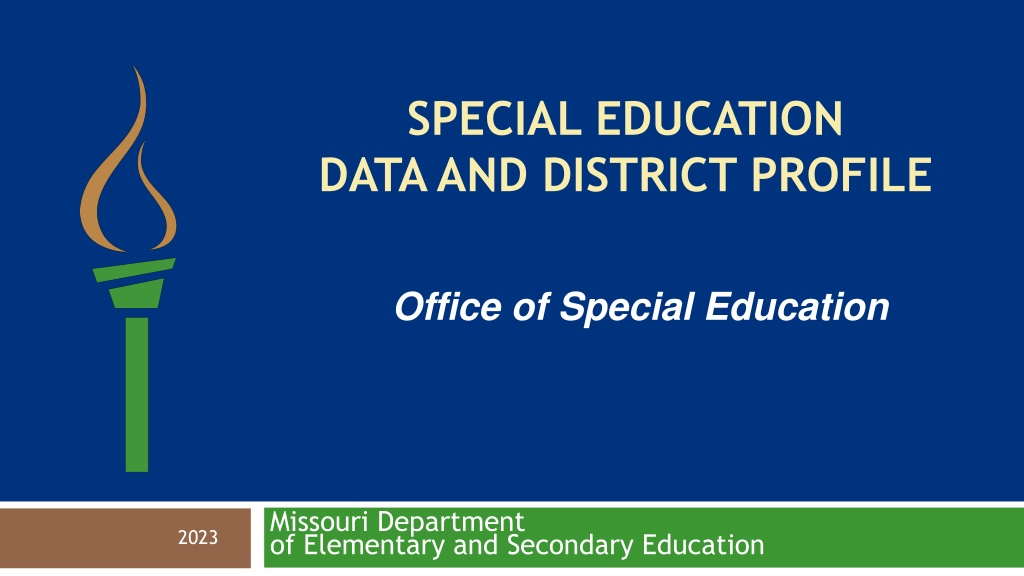
 undefined
undefined













